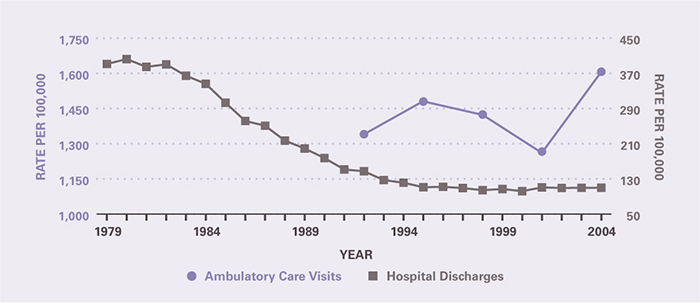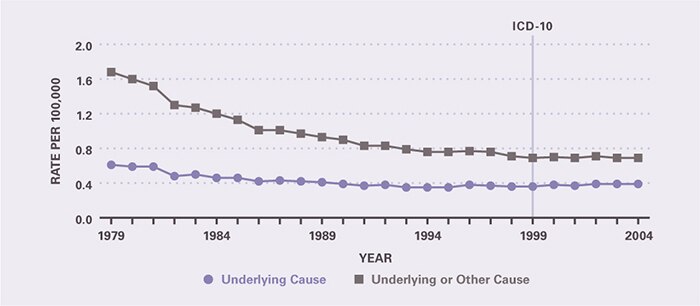Chapter 18: Abdominal Wall Hernia
James E. Everhart, M.D., M.P.H.
Abdominal wall hernias (AWH) are coded by their anatomical location (direct and indirect inguinal, femoral, and umbilical, plus other or unspecified) and subcoded by complication (obstruction, with or without gangrene) in ICD-10. Coding was different in ICD-9, which had an odd combination of location and complication (Appendix 1). However, the individual codes match up fairly well between the two editions.
The large majority of AWH are inguinal hernias, which frequently occur as a result of incomplete closure of the inguinal canal in male infants. Hence, there was a substantial number of ambulatory care visits among children and more than twice the rate among males as females in 2004 (Table 1). However, among adults, the rate of visits increased progressively with age. Whites had a higher rate than blacks. Rates have not changed appreciably since 1975.14 AWH was the third leading cause of ambulatory care visits in 2004, after GERD and constipation. Rates of hospital discharges with AWH were higher among blacks and there was little difference by sex.
The definitive treatment of AWH is by surgical repair. Because most repairs no longer require overnight hospitalization, the rate of hospitalizations has declined substantially, largely over a 10-year period between 1983 and 1993 (Figure 1). This decline was mostly accounted for by substantial reduction in the number of direct hernia repairs among males.15 The same decline did not occur among females, which may account for the similar discharge rates between males and females.
In 2004, more than 1,000 persons died with AWH as the underlying cause (Table 2). The large majority of deaths occurred among persons age 65 years and older. Mortality rates were similar for whites and blacks and for males and females. Mortality rates declined between 1979 and the mid-1990s for AWH as underlying cause and more substantially as underlying or other cause (Figure 2). Mortality rates were then stable through 2004.
Because AWH is primarily a surgical condition, prescriptions filled at retail pharmacies captured through the Verispan database (Appendix 2) may not have captured the extent and nature of medication use for these conditions. In 2004, there were an estimated 3.7 million retail prescriptions filled, at a cost of $59.5 million. More than 97 percent of these prescriptions were for analgesics, with the rest for antimicrobial agents.
References
Table 1. Abdominal Wall Hernia: Number and Age-Adjusted Rates of Ambulatory Care Visits and Hospital Discharges With First-Listed and All-Listed Diagnoses by Age, Race, and Sex in the United States, 2004
| Demographic Characteristics | Ambulatory Care Visits First-Listed Diagnosis Number in Thousands | Ambulatory Care Visits First-Listed Diagnosis Rate per 100,000 | Ambulatory Care Visits All-Listed Diagnosis Number in Thousands | Ambulatory Care Visits All-Listed Diagnosis Rate per 100,000 | Hospital Discharges First-Listed Diagnosis Number in Thousands | Hospital Discharges First-Listed Diagnosis Rate per 100,000 | Hospital Discharges All-Listed Diagnosis Number in Thousands | Hospital Discharges All-Listed Diagnosis Rate per 100,000 |
|---|---|---|---|---|---|---|---|---|
| AGE (Years) Under 15 |
160 | 264 | 417 | 685 | 5 | 8 | 24 | 40 |
| AGE (Years) 15–44 |
1,113 | 885 | 1,278 | 1,016 | 29 | 23 | 65 | 52 |
| AGE (Years) 45–64 |
1,492 | 2,111 | 1,804 | 2,552 | 60 | 84 | 124 | 176 |
| AGE (Years) 65+ |
976 | 2,686 | 1,288 | 3,545 | 69 | 189 | 158 | 435 |
| Race White |
3,347 | 1,348 | 4,223 | 1,703 | 130 | 51 | 290 | 115 |
| Race Black |
287 | 858 | 437 | 1,275 | 17 | 54 | 47 | 142 |
| Sex Female |
1,056 | 681 | 1,526 | 987 | 86 | 54 | 194 | 121 |
| Sex Male |
2,686 | 1,902 | 3,261 | 2,317 | 75 | 56 | 177 | 132 |
| Total | 3,742 | 1,274 | 4,787 | 1,630 | 163 | 55 | 372 | 127 |
Figure 1. Abdominal Wall Hernia: Age-Adjusted Rates of Ambulatory Care Visits and Hospital Discharges With All–Listed Diagnoses in the United States, 1979–2004

Table 2. Abdominal Wall Hernia: Number and Age-Adjusted Rates of Deaths and Years of Potential Life Lost (to Age 75) by Age, Race, and Sex in the United States, 2004
| Demographic Characteristics | Underlying Cause Number of Deaths | Underlying Cause Rate per 100,000 | Underlying Cause Years of Potential Life Lost in Thousands | Underlying or Other Cause Number of Deaths | Underlying or Other Cause Rate per 100,000 |
|---|---|---|---|---|---|
| AGE (Years) Under 15 |
10 | 0.0 | 0.7 | 21 | 0.0 |
| AGE (Years) 15–44 |
43 | 0.0 | 1.6 | 70 | 0.1 |
| AGE (Years) 45–64 |
197 | 0.3 | 3.8 | 384 | 0.5 |
| AGE (Years) 65+ |
922 | 2.5 | 0.8 | 1,624 | 4.5 |
| Race White |
1,015 | 0.4 | 5.3 | 1,815 | 0.7 |
| Race Black |
133 | 0.5 | 1.5 | 246 | 0.9 |
| Sex Female |
670 | 0.4 | 3.2 | 1,132 | 0.6 |
| Sex Male |
502 | 0.4 | 3.7 | 967 | 0.8 |
| Total | 1,172 | 0.4 | 6.9 | 2,099 | 0.7 |
Figure 2. Abdominal Wall Hernia: Age-Adjusted Rates of Death in the United States, 1979–2004


